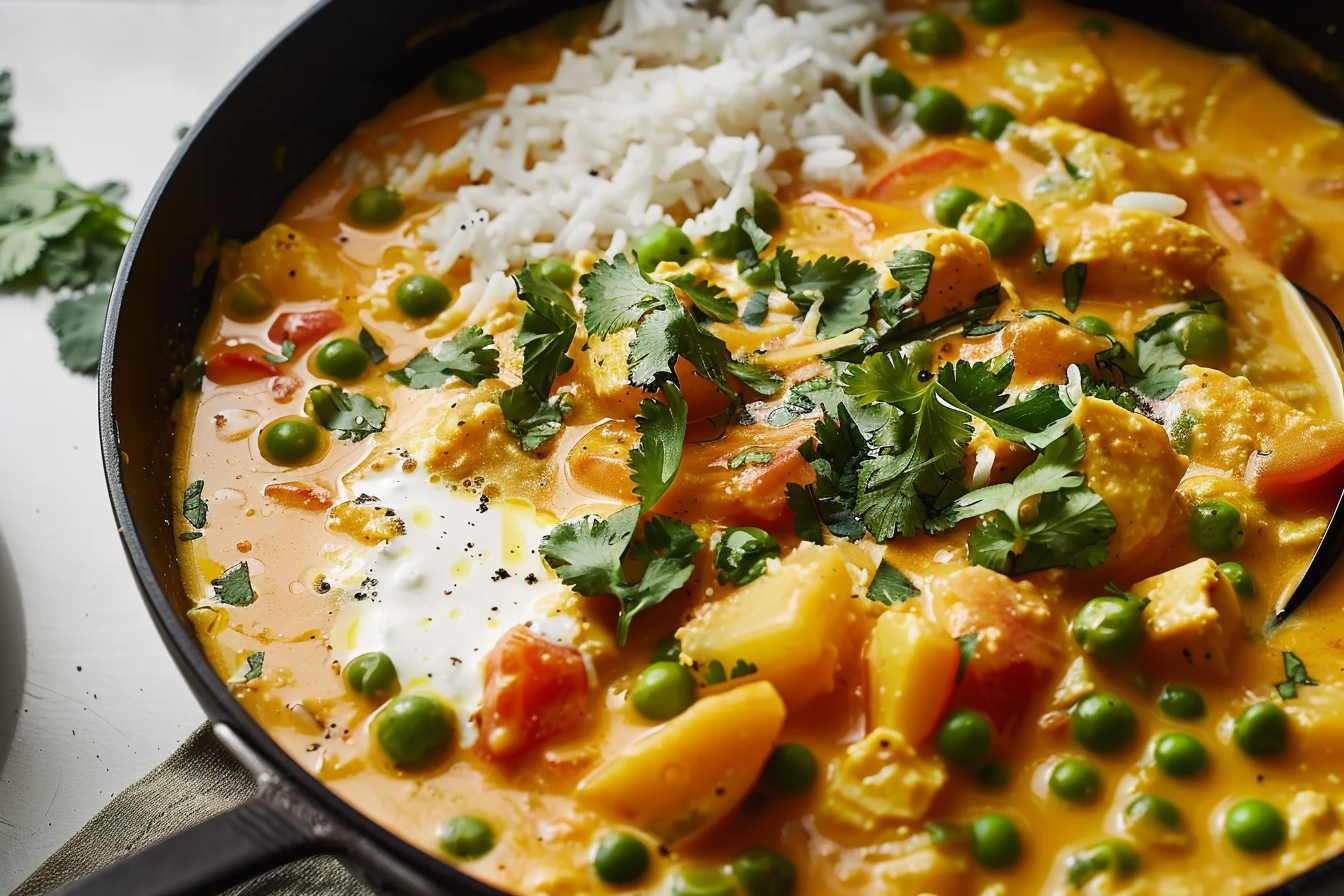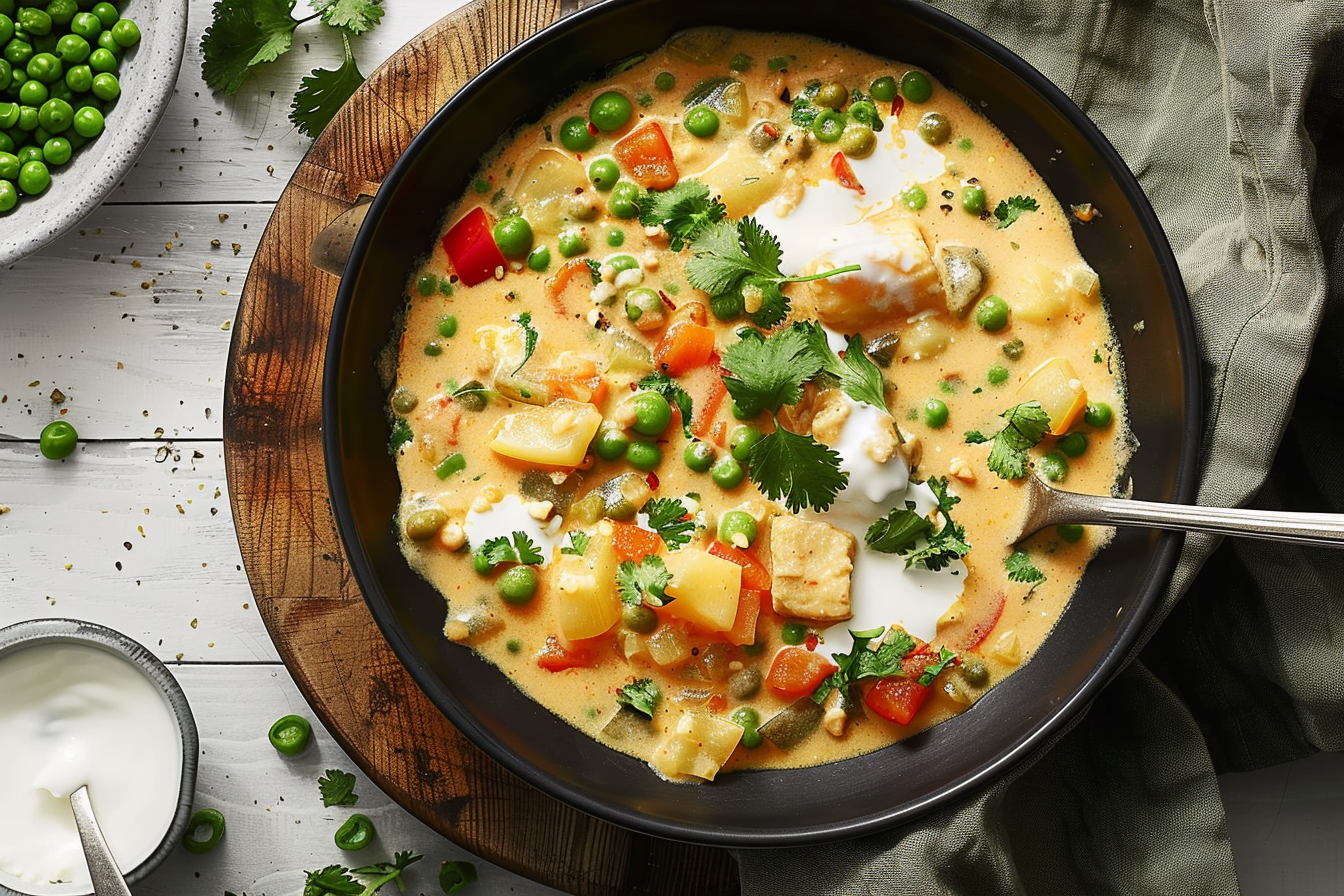Introduction to Vegetarian Korma Recipe
Overview of Korma
Vegetarian Korma recipe is a rich and flavorful dish rooted in the history of Indian cuisine. Traditionally, Korma is a dish where meat or vegetables are braised with yogurt or cream and aromatic spices to create a luxurious, creamy sauce. Over time, the vegetarian variant has gained immense popularity, especially among those seeking meat-free alternatives without sacrificing taste and depth of flavor.
Vegetarian Korma
A vegetarian korma stands out for its diverse ingredients and intricate spice blends. This dish offers a symphony of flavors, combining the sweetness of carrots and bell peppers with the earthy richness of potatoes and cashews. This dish showcases that vegetarian meals can be both fulfilling and luxurious. The creamy sauce, enhanced by the blend of spices and the addition of heavy cream, makes every bite a delight. For those interested in exploring other authentic Indian recipes, this resource provides a variety of options to experiment with in the kitchen.
Purpose of the Article
This article aims to guide you through the process of making an exquisite vegetarian korma at home. Whether you’re exploring Indian cuisine for the first time or a seasoned chef in search of fresh ideas, this guide has all you need. You’ll learn about the ingredients, step-by-step instructions, advanced techniques, and tips for dietary adaptations. Additionally, it includes practical advice on storing and reheating leftovers. For additional advice on mastering your korma, consider these helpful suggestions.
With this comprehensive guide, you’ll be able to create a delicious vegetarian korma that will impress family and friends, bringing a taste of India into your home.
Basic Recipe Overview
Print
Vegetarian Korma Recipe
- Total Time: 50 minutes
- Yield: 4 servings 1x
- Diet: Vegetarian
Description
A rich and creamy Indian curry made with a variety of vegetables and a blend of aromatic spices, perfect for a comforting meal.
Ingredients
- 1 ½ tablespoons vegetable oil
- 1 small onion, diced
- 4 cloves garlic, minced
- 1 teaspoon minced fresh ginger root
- 4 carrots, cubed
- 2 potatoes, cubed
- 1 (4 ounce) can tomato sauce
- 3 tablespoons ground unsalted cashews
- 1 fresh jalapeno pepper, seeded and sliced
- 1 ½ tablespoons curry powder
- 2 teaspoons salt
- 1 cup heavy cream
- 1 cup frozen green peas
- ½ green bell pepper, chopped
- ½ red bell pepper, chopped
- 1 bunch fresh cilantro for garnish
Instructions
- Heat the vegetable oil in a large skillet over medium heat.
- Add the diced onion and cook until softened, about 5 minutes.
- Stir in the garlic and ginger, and cook for another 2 minutes.
- Add the carrots and potatoes, cooking until they begin to soften, about 10 minutes.
- Stir in the tomato sauce, ground cashews, and jalapeno pepper.
- Add the curry powder and salt, mixing well.
- Pour in the heavy cream and bring the mixture to a simmer.
- Stir in the green peas, bell peppers, and cook until all the vegetables are tender, about 10 minutes.
- Garnish with fresh cilantro before serving.
Notes
Adjust the spice level by adding more or less jalapeno pepper. Serve with rice or naan for a complete meal.
- Prep Time: 20 minutes
- Cook Time: 30 minutes
- Category: Main Course
- Method: Stovetop
- Cuisine: Indian
Nutrition
- Serving Size: 1 serving
- Calories: 300
- Sugar: 6g
- Sodium: 900mg
- Fat: 20g
- Saturated Fat: 10g
- Unsaturated Fat: 8g
- Trans Fat: 0g
- Carbohydrates: 25g
- Fiber: 6g
- Protein: 6g
- Cholesterol: 30mg
Keywords: Vegetarian Korma
For more healthy vegetarian recipes, check out this collection.
STEPS
Step 1
Gather all ingredients.
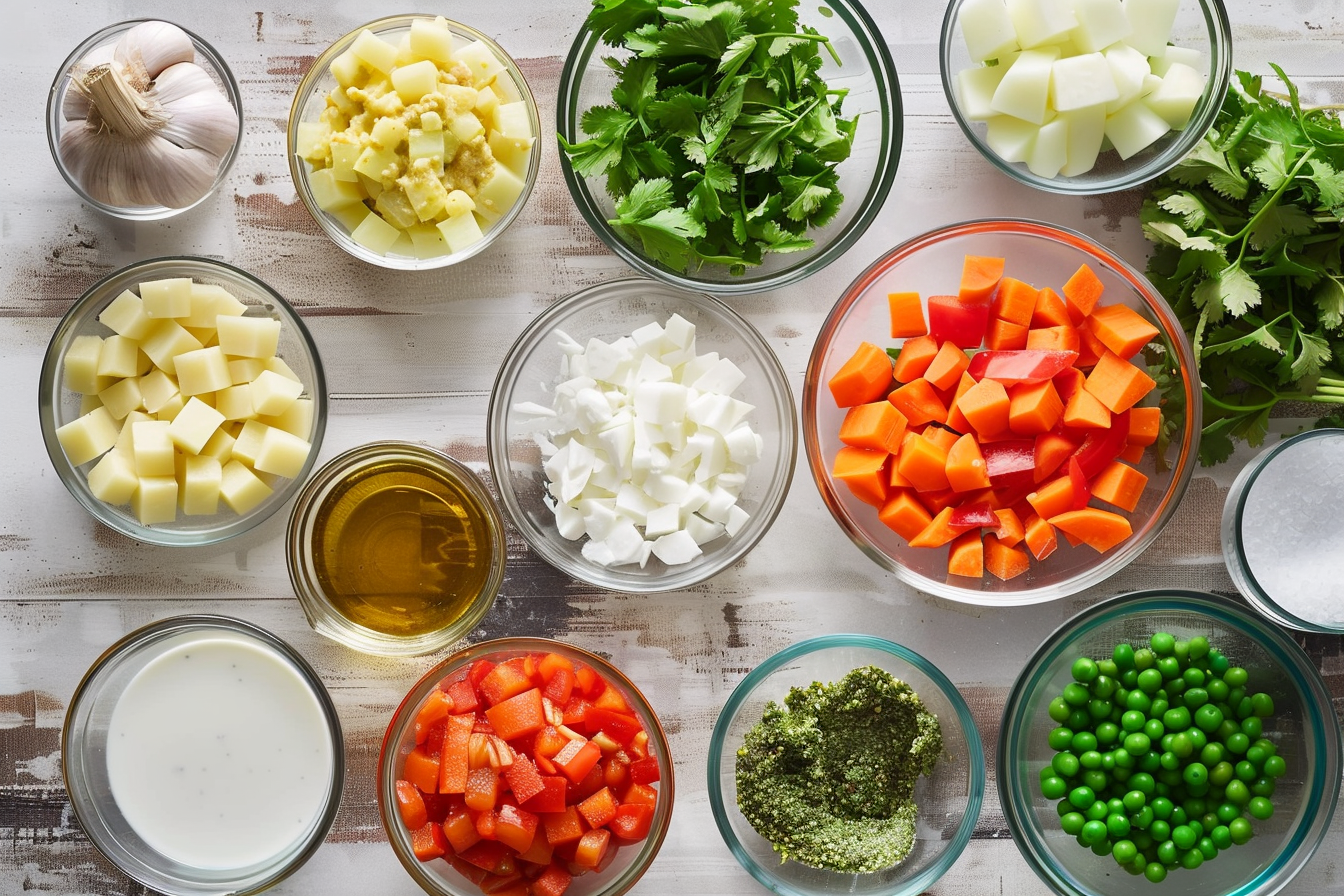
Step 2
Warm oil in a pan on medium heat. Sauté the onion until it’s soft, which should take about 2 to 3 minutes. Mix in the garlic and ginger and continue to stir until the aroma is noticeable, roughly 1 minute.

Step 3
Add carrots, potatoes, tomato sauce, cashews, and jalapeño to the mix. Season with curry powder and salt, then continue to cook and stir until the potatoes become soft, which usually takes around 10 minutes.
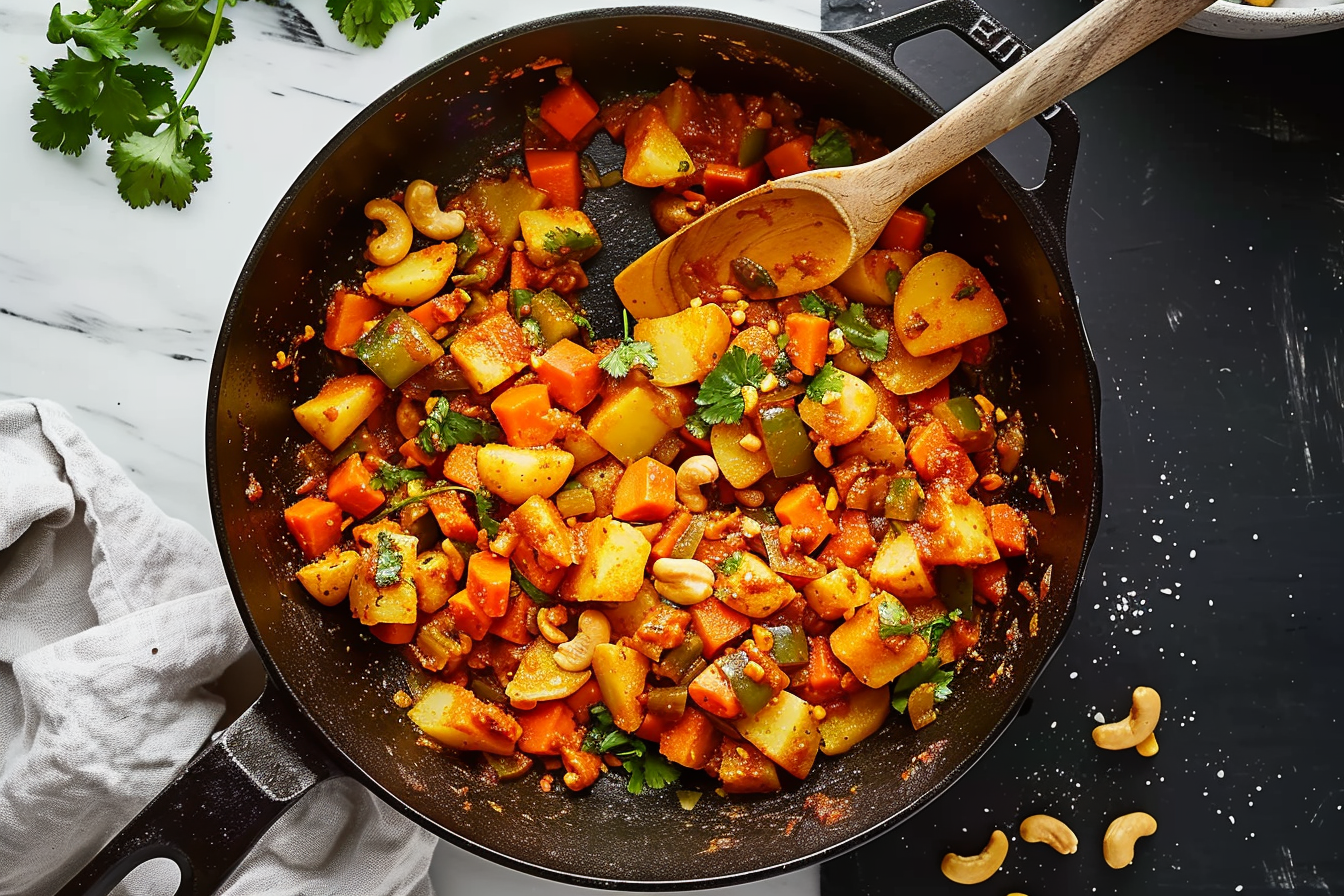
Step 4
Mix in the cream, peas, green bell pepper, and red bell pepper; turn down the heat to low, cover the pan, and let it simmer for 10 minutes. Top with cilantro before serving.
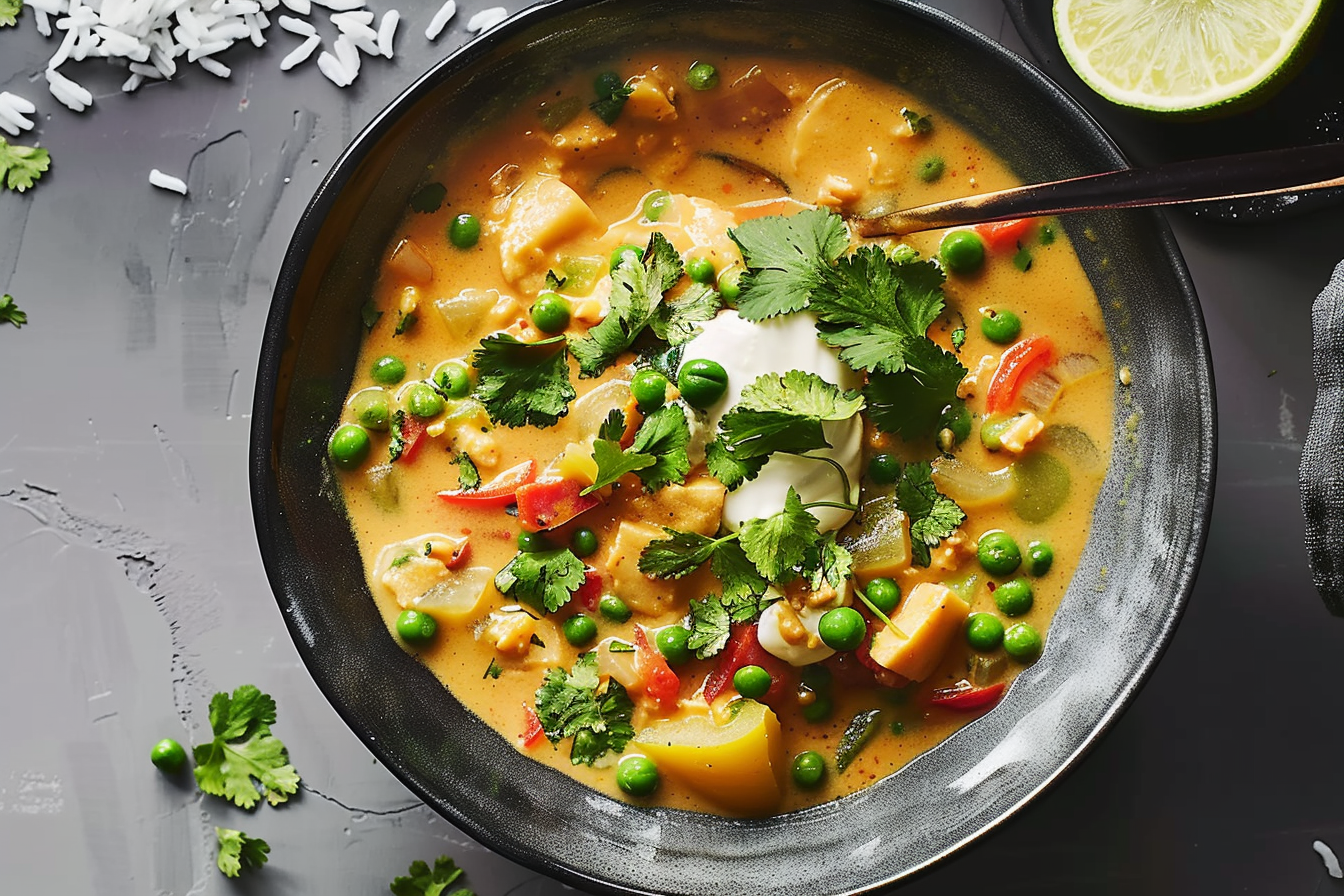
Advanced Techniques
Enhancing Flavor and Texture
To elevate your vegetarian korma recipe, consider roasting spices before adding them to the dish. This step releases essential oils, deepening the flavor profile. Start by dry-roasting the curry powder and cashews until they turn aromatic. This simple technique can transform the dish from ordinary to extraordinary.
Another way to enhance the creaminess of your korma is by incorporating coconut milk or yogurt instead of heavy cream. Both options add a unique richness while keeping the dish light. Coconut milk introduces a subtle sweetness that pairs wonderfully with the spices, while yogurt adds a tangy twist.
To achieve perfectly tender vegetables without them becoming mushy, ensure you cut them into uniform pieces. Cooking them at a consistent temperature helps maintain their texture. Begin with harder vegetables like carrots and potatoes, then add softer ones such as peas and bell peppers towards the end of the cooking process.
Balancing Spices and Heat
Balancing spices and heat is crucial in a vegetarian korma recipe. If you enjoy a bit more heat, add extra jalapeno or a dash of cayenne pepper to the dish. For a less spicy dish, cut down on the jalapeños or swap them for sweet bell peppers. Taste the korma throughout the cooking process to adjust the seasoning as needed.
Adding Protein
Incorporating protein into your vegetarian korma recipe can make it more nutritious and satisfying. Think about incorporating chickpeas or paneer into the mix. Chickpeas not only provide a significant amount of plant-based protein but also contribute a delightful texture to the dish. Paneer, an Indian cheese, adds a creamy, chewy element that complements the korma sauce.
Cooking Tips for Indian Cuisine
For more tips on cooking Indian cuisine, visit Cooking Tips for Indian Cuisine. This resource offers a wealth of information on perfecting your Indian dishes, from spice blending to cooking techniques.
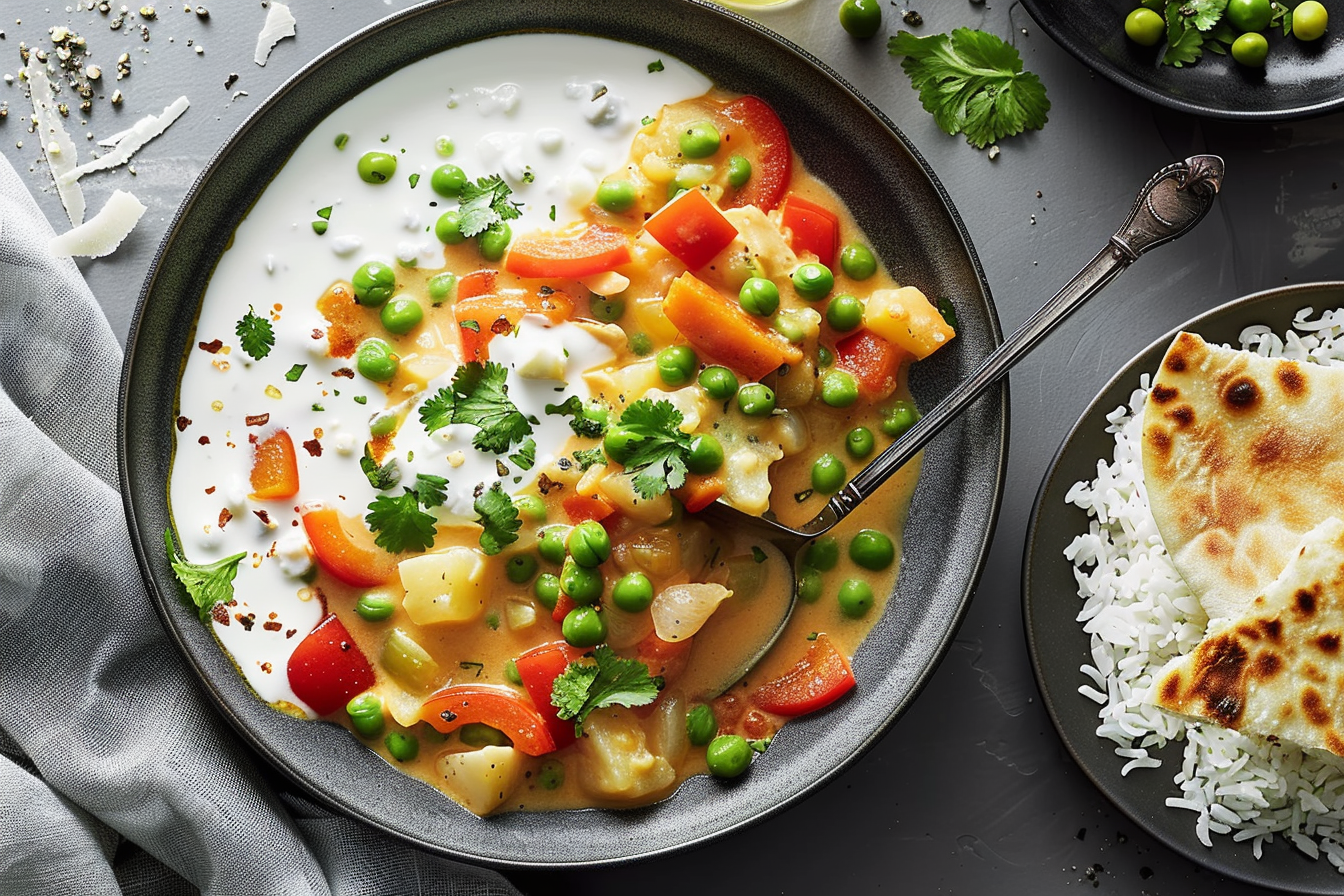
Maintenance Tips
Storage and Reheating
Proper storage is essential for keeping your vegetarian korma recipe fresh and flavorful. Preserve any leftover korma in an airtight container and refrigerate. This will help maintain the dish’s integrity for up to four days. For extended storage, consider freezing the korma. Make certain the container is securely closed to avoid freezer burn.
For optimal results when reheating, prefer using the stovetop. Reheat the korma slowly on low to medium heat, stirring now and then to avoid any sticking. Using this method ensures the korma maintains its creamy consistency and lively flavors. Steer clear of microwaving, as it can make the vegetables too soft.
Rejuvenating Leftovers
Often, leftovers may taste better as the flavors have more time to integrate. Should the korma become overly thick, introduce a splash of water or vegetable broth during the reheating process. This will restore its original consistency without diluting the taste. To enhance freshness, top with fresh cilantro just before serving.
Flavor Enhancement
To enhance the flavors of your vegetarian korma recipe when reheating, consider adding a squeeze of fresh lemon juice. A dash of acidity from the garnish can elevate the dish, complementing its richness. Additionally, a dollop of plain yogurt on top can provide a cool contrast to the spices.
Freezing Tips
If you plan to freeze your korma, avoid adding the heavy cream before freezing. Instead, add the cream after thawing and reheating the dish. This prevents the cream from separating and ensures a smooth, creamy texture. Mark the container with the date to easily monitor the storage duration.
Serving Suggestions
Serve your reheated vegetarian korma recipe with freshly cooked rice or warm naan. Together, these steps ensure a fulfilling and enjoyable meal. Additionally, a side of cucumber raita can complement the spices and provide a cooling effect.
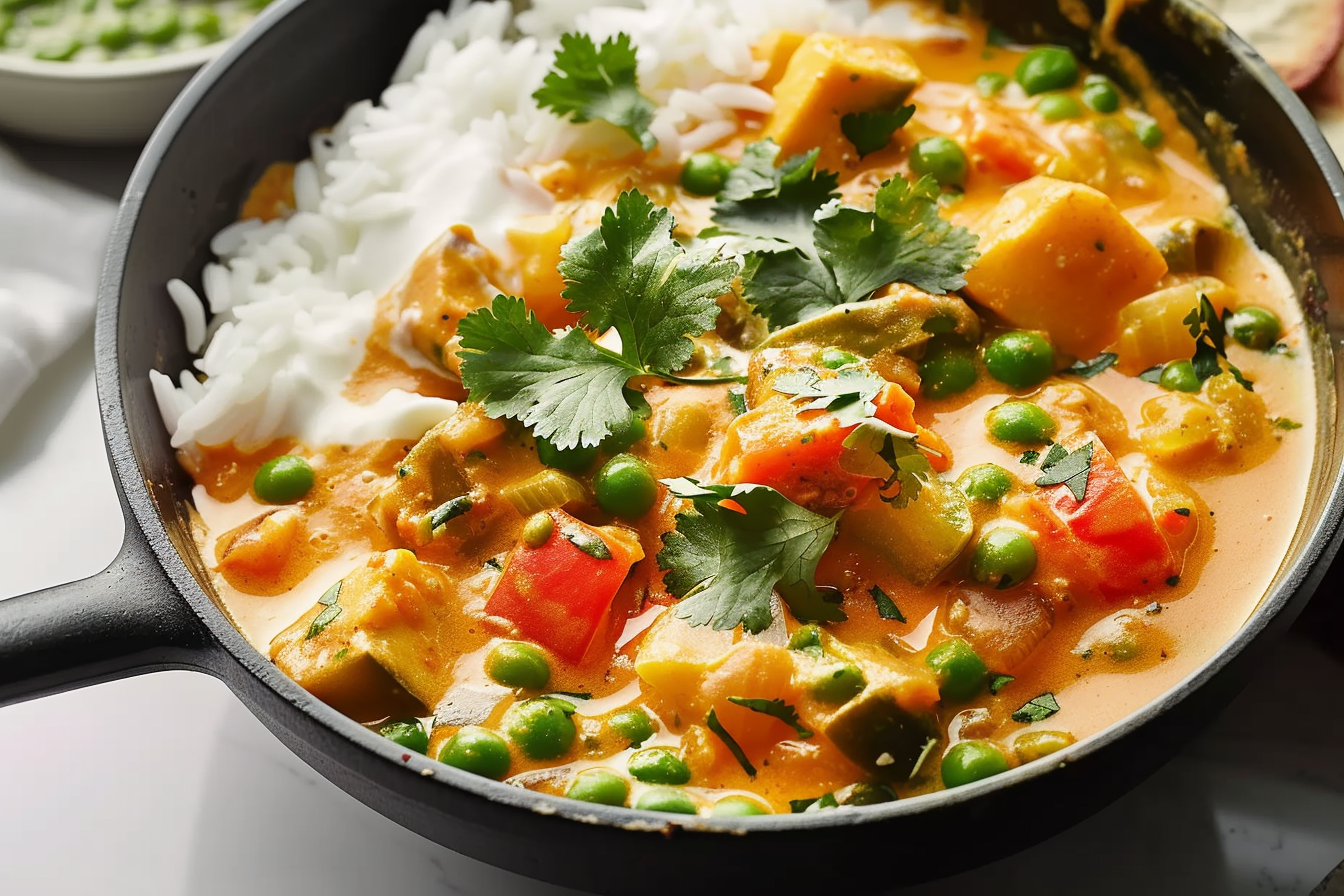
Dietary Adaptations
Vegan Options
Transforming your vegetarian korma recipe into a vegan delight is simple. Substitute the heavy cream for either coconut milk or cashew cream. These substitutes maintain a creamy consistency without using dairy. Coconut milk adds a slight sweetness that pairs well with the spices, while cashew cream offers a neutral, rich base.
Gluten-Free Adjustments
Ensuring your vegetarian korma recipe is gluten-free involves careful selection of ingredients. Most of the components are naturally gluten-free. However, always double-check labels on spices and tomato sauce to avoid hidden gluten. Complement your korma with a serving of gluten-free rice or quinoa to create a full meal.
Low-Sodium Modifications
For those needing a low-sodium version of the vegetarian korma recipe, reduce the salt amount and use low-sodium tomato sauce. Enhancing flavors with fresh herbs like cilantro and spices can compensate for the reduced salt. This approach maintains the dish’s robust taste without the added sodium.
Adding More Protein
Incorporate more protein into your vegetarian korma recipe by adding ingredients like chickpeas, lentils, or tofu. Chickpeas blend seamlessly with the creamy sauce and provide a hearty texture. Lentils, on the other hand, cook quickly and absorb the korma’s flavors well. Tofu, when cubed and lightly fried, adds a satisfying bite.
Nut-Free Variations
For those avoiding nuts, modify the vegetarian korma recipe by skipping the ground cashews and replacing them with sunflower seed butter or tahini. These alternatives help maintain the dish’s creaminess without compromising on taste. Additionally, they cater to those with nut allergies while keeping the recipe versatile.
Spice Level Adjustments
Adjusting the spice level of your vegetarian korma recipe is easy. For a milder version, reduce the amount of jalapeno pepper or replace it with sweet bell peppers. To increase the heat, add more jalapeno or a pinch of cayenne pepper. Tasting and adjusting throughout the cooking process ensures the perfect spice balance.
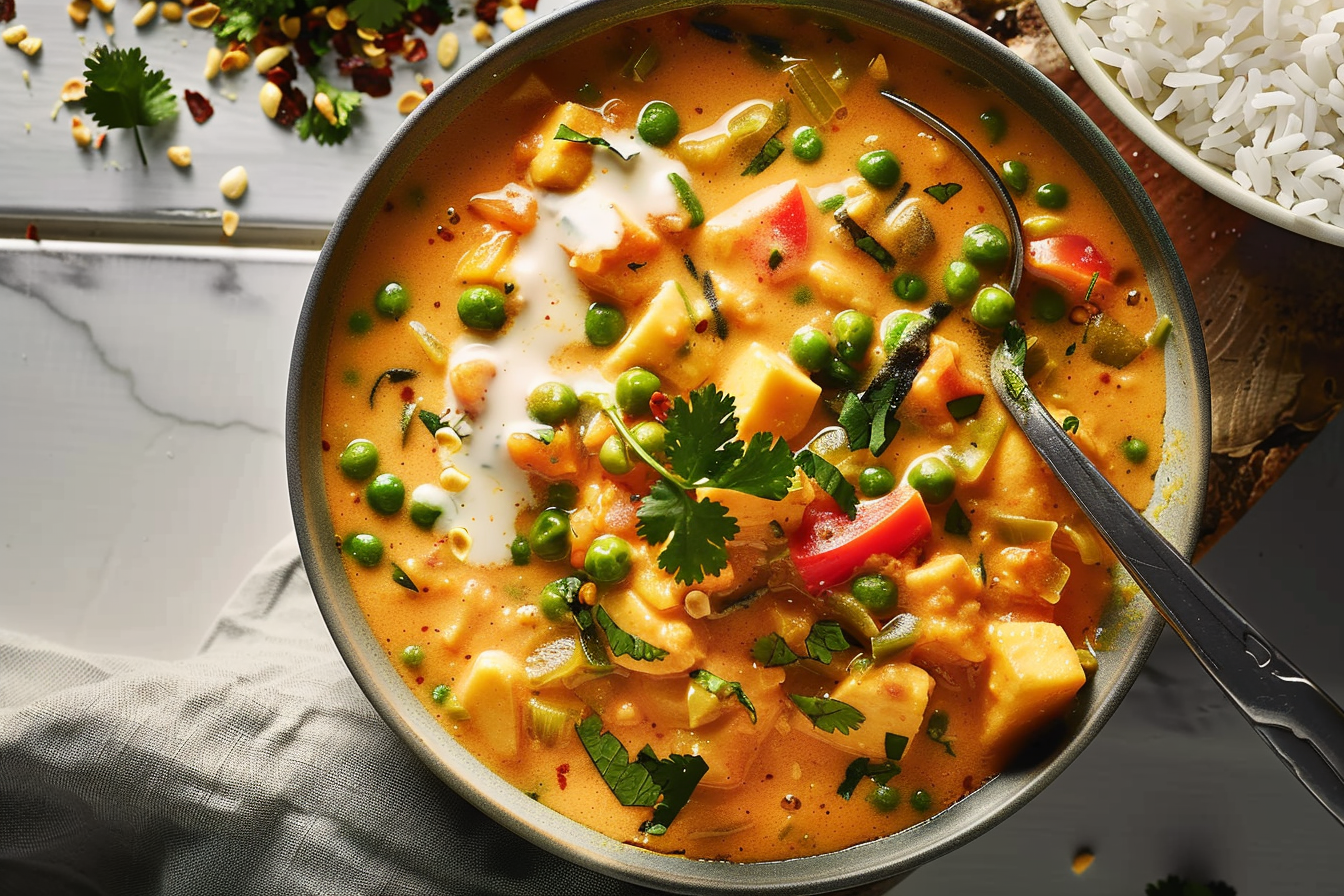
Frequently Asked Questions (FAQs)
Is it possible to use different vegetables in this recipe?
Absolutely! The beauty of the vegetarian korma recipe lies in its versatility. Feel free to experiment with different vegetables. Cauliflower, zucchini, and sweet potatoes are excellent additions. Simply modify the cooking duration to guarantee that all vegetables are cooked to tenderness without being overdone.
How can I adjust the heat level of this dish to be spicier or more mild?
To tailor the spice level of your vegetarian korma recipe, adjust the amount of jalapeno pepper used. For a spicier kick, add more jalapeno or a pinch of cayenne pepper. For a less spicy flavor, decrease the amount of jalapeno or substitute it with sweet bell peppers. Continuously taste the dish to find the ideal flavor balance.
What are the best types of rice or bread to pair with korma?
Traditionally, vegetarian korma pairs beautifully with basmati rice or naan bread. Basmati rice, with its fragrant aroma, complements the creamy sauce perfectly. Naan bread, on the other hand, is great for scooping up the korma. Opt for brown rice or whole wheat naan for a healthier accompaniment.
Can I prepare korma in advance and how should I store it?
Yes, preparing your vegetarian korma recipe in advance is convenient and can enhance the flavors. Keep the cooked korma in a sealed container in the fridge for a maximum of four days. For extended storage, freeze the korma in appropriate containers. When ready to serve, thaw and reheat gently on the stovetop, adding a splash of water or broth if necessary.
These frequently asked questions offer valuable insights and tips for mastering your vegetarian korma. Tailor the dish to your taste and dietary requirements by varying ingredients and cooking techniques.
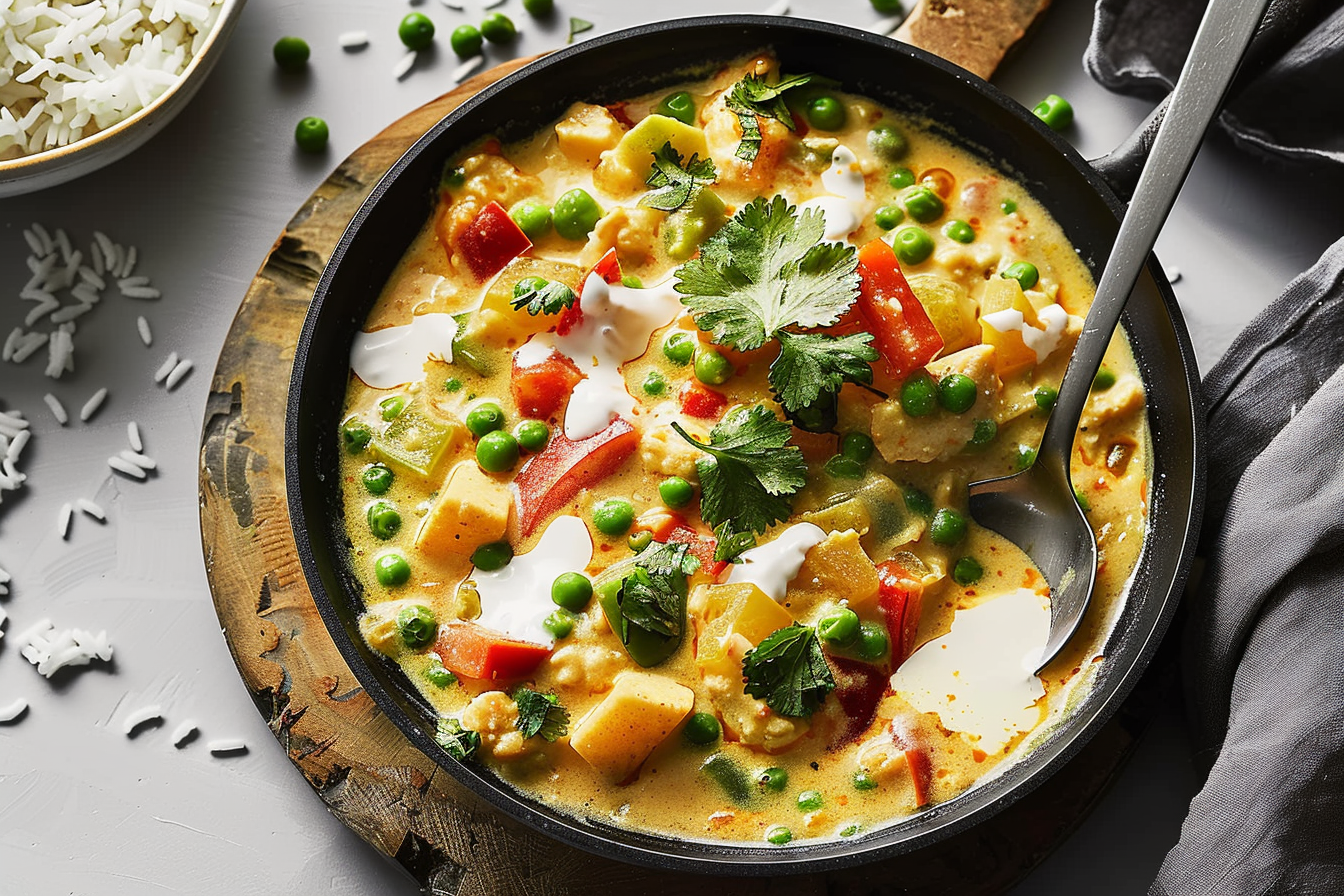
Additional Resources and External Links
Recommended Reads and Resources
To deepen your understanding of Indian cuisine and enhance your vegetarian korma recipe further, here are some valuable resources and reads. These will provide you with more tips, recipes, and insights into perfecting your Indian cooking skills.
Authentic Indian Vegetarian Recipes
For those who wish to explore more traditional Indian vegetarian dishes, check out Authentic Indian Vegetarian Recipes. This resource offers a wide array of dishes that highlight the rich diversity of Indian vegetarian cuisine. From basic dals to intricate biryanis, you’ll discover recipes that cater to all events and cooking expertise.
Cooking Tips for Indian Cuisine
Improving your Indian cooking techniques can elevate all your dishes, not just your vegetarian korma recipe. Visit Cooking Tips for Indian Cuisine for expert advice on everything from spice selection to cooking methods. These pointers will guide you in attaining genuine tastes and ideal consistencies in your dishes.
Health Benefits of a Vegetarian Diet
Understanding the health benefits of a vegetarian diet can motivate you to incorporate more plant-based meals into your routine. Explore Health Benefits of a Vegetarian Diet to learn about the positive impacts of vegetarianism on health and wellness. This resource discusses nutritional benefits, weight management, and the environmental impact of a plant-based diet.
Conclusion
By leveraging these resources, you can enhance your culinary skills and knowledge, making your vegetarian korma recipe and other dishes even more delightful. Whether you’re a novice cook or an experienced chef, there’s always something new to learn in the world of Indian cuisine. Dive into these recommended reads to expand your repertoire and enjoy the rich, diverse flavors that Indian vegetarian dishes have to offer.
